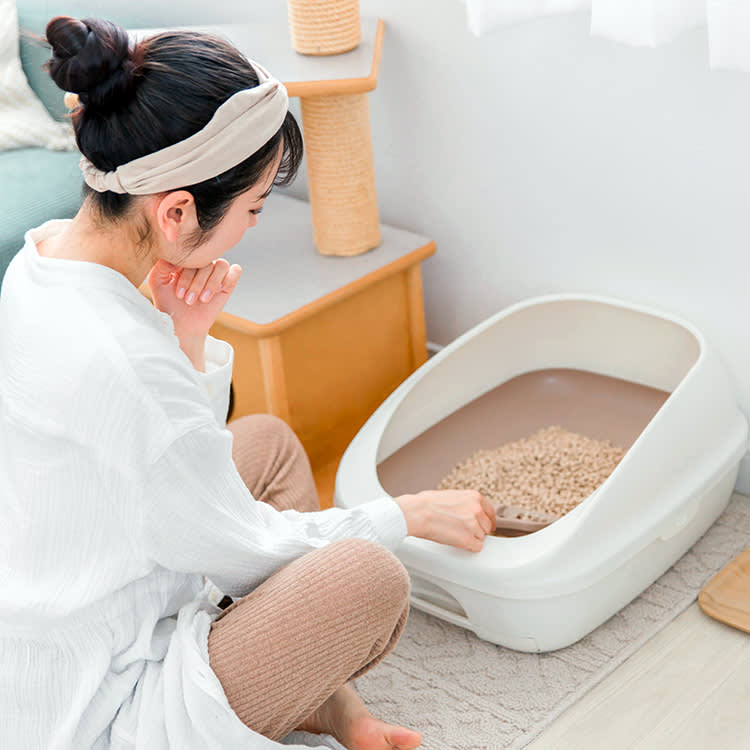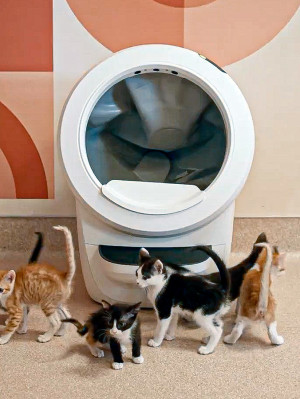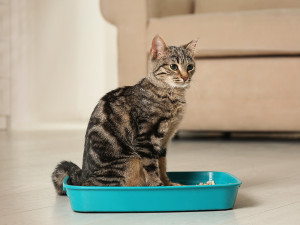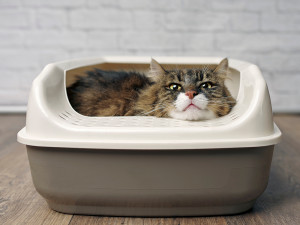A Complete Guide to How Often to Change Your Cat’s Litter
It’s not gonna change itself!

Share Article
In This Article
When to Change Your Cat’s Litter Signs It’s Time to Change the Litter Box Tips for Maintaining the Litter Box Frequently Asked Questions
Cat litter is a hot topic. There’s lots of debate about what kind of cat litter is best for your cat, for the environment and for you. Don’t be swayed by claims that cat litter is compostable or flushable. It’s not. Do consider how much time and money you can devote to the chore because whether you have one or more cats, keeping your home (and your cats’ bathroom) fresh and odor-free is essential.
Like so many other products, cat litter gives you a lot of choices. It may cost more depending on how long it lasts and what’s in it. Is it dusty, fine or coarse? Does it absorb odors? Does your cat like it? No matter what litter you choose (or you cat chooses for you), unless you’re using an automatic litter box you should commit to sifting solids and urine from the box at least once a day and, ideally, replacing the litter every week or when it starts to smell.
Main takeaways
Cat litter comes in many types and you may need to experiment until you find the right one.
Plan to sift out solids and urine every day and change the litter completely once a week. If you don’t clean and change cat litter frequently, you and your cat risk health problems.
Frequent cleaning contributes to long-lasting litter.
What happens if you don’t change the cat litter?
Think of stepping into a portable toilet that hasn’t been cleaned and being tempted to go in the woods instead. Like much of being a pet parent, routine (in this case, regular cleaning) is good for you and your cat and alleviates the nagging guilt of smelly litter and health problems. When the box gets too dirty, a cat might be deterred from using it and you’ll find unpleasant surprises around the house. Feline feces contain bacteria, viruses and parasites that can infect other cats and sometimes people. Keeping the litter clean ensures less risk of contact with contaminated feces.
Cleaning experts see a lot of litter boxes. Galia Ivanova, the founder and CEO of Cleaning Estimate, a company dedicated to providing exceptional cleaning services to homes and businesses in the greater London area, observes litter for a living. She also has a few very opinionated cats of her own.

“When it’s not changed frequently, litter can harbor bacteria and increase ammonia levels, which isn’t just about smell,” Ivanova says. “I’ve known clients whose cats developed urinary issues and started avoiding the box entirely because it smelled unpleasant to them. The last thing we want is a frustrated cat deciding the living room rug is a better alternative.”
When to change your cat litter based on the type
Clumping litter
Most clumping litter is made from bentonite, a type of clay that binds to urine and forms hard clumps, leaving unsoiled litter behind. While that means it may not have to be changed as often, it loses points because it produces dust that can irritate cats’ lungs. Clumping litter also sticks to cats’ paws and gets tracked around the house. When urine collects at the bottom of a box of clumping litter, you’ll detect the ammonia smell that signals it’s time to empty and scrub the box. Plan to do that at least once a month, Ivanova says.
Non-clumping litter
Non-clumping litter was the first commercially-available type of cat litter. Non-clumping litter won’t let you be as selective about what you scoop, so you’ll be throwing out more material with each cleaning. But it’s less dusty and lasts longer. “Non-clumping litter usually needs more frequent total changes, maybe every week or so since it’s harder to remove all the soiled spots,” Ivanova says.
Paper- and wood-based litter
Paper- and wood-based or plant-based litters have become very popular in recent years because they’re made from agricultural by-products and therefore considered more sustainable. They’re lightweight and absorbent and less likely to stick to cats’ paws. Do they affect how often you need to change the litter? No. In fact, says Ivanova, expect to replace them every fice to seen days, because they break down quickly once they get wet.
Silica cat litter
Also called crystal cat litter, silica cat litter is similar to the silica gel inside desiccant packets. It’s designed to be highly absorbent and long-lasting so you could get away with cleaning less frequently. But it’s typically more expensive and some cats don’t like the crunchy texture of silica between their toes. Ivanova says silica crystals last longer before they need a complete swap — about a month — but you’ll know it’s time when the crystals stop absorbing moisture.
Litter Robot
What could be better than a fully automatic, self-cleaning litter box? The Litter Robot opens in new tab works by disposing of used litter after your cat uses the box, which resembles a sleek capsule). By automatically cycling after each use, the Litter Robot eliminates dust, germs and litter box odors. The patented sifting technology uses less litter and claims to save in litter what it costs (about $700).
But where does that poop go? Into a drawer beneath the capsule that still needs to be emptied once or twice week depending on the number of cats using the Litter Robot. Ivanova says the machine helps with daily maintenance and she finds emptying the collection drawer once a week or every 10 days keeps it truly odor-free. While the Litter Robot sounds ideal, be warned nothing is automatic for cats and not every cat takes to it.
Signs it’s time to change the cat litter box
You smell something stinky.
Unpleasant odors are usually the first sign it’s time to clean the litter box.
You see an overwhelming amount of poop.
Some cats bury their poo, some don’t. Poop-covering is like any other behavior with a lot of variation between cats and even the same cat day-to-day. Poop is unsightly so you’ll be reminded all the sooner that it’s time to clean the box.
Your cat has started to go outside the litter box.
Dirty litter is the first, and sometimes easiest, item to check off when cats start to poop and pee where they shouldn’t. But if you clean the litter and the unwanted behavior continues, consider whether your cat likes the location of the box, whether there’s been a sudden change in your cat’s environment or whether they’re feeling boxed in (some cats don’t like litter boxes with lids).
How much litter should you put in a litter box?
Some experts advise filling a litter box to a depth of one inch; others suggest more. In general, fill with enough new litter for your cat to be able to dig and bury their waste. “A good two to three inches is usually just right. My cats have never cared for very deep litter and too shallow means you’re dealing with more sticking to the bottom,” Ivanova says.
What happens when you don't have enough cat litter in the box?
Your cat may choose to go elsewhere if they can’t bury their litter. Low levels of litter will also fail to disguise unpleasant odors.
How to dispose of cat litter
Repeat after me: Cat litter is not flushable, for a long list of reasons. All types of cat litter will clog drains and pipes. And cat poop contains harmful pathogens and parasites that can infect other humans and animals through the water supply. The best way to dispose of cat litter is bagging it and putting it in the trash.
Factors that contribute to litter change frequency
Number of cats
The number of cats in your home will determine the number of litter boxes you need. The general rule of thumb is one box per cat because while cats can, conceivably, share a litter box, their territorial nature works against our desire for simplicity.
Number of litter boxes
Experts agree the general rule of thumb is “N” plus one, “N” being the number of cats you have. Two cats equals three litter boxes.
Type of litter box
This is a topic as exhaustive as what type of litter to buy and how often to change it. There are boxes with and without lids, with low sides and high sides, and boxes disguised as end tables and potted plants. There are also a number of self-cleaning litter boxes in addition to the Litter Robot. Regardless, all boxes require daily maintenance.
Your cat’s health, diet, and preferences
Cats seem to overwhelmingly prefer unscented litter. Using that as a your starting point, fill the box and observe how quickly it gets dirty. Cats who eat a lot of wet food will saturate the litter more quickly. Cats with urinary tract infections or other health issues may need their litter changed more frequently. Older cats might use the box more, too.
Tips for maintaining a clean litter box
The more often you change the litter box, the cleaner it will be. Especially if you live in a small space like an apartment with no access to a hose. Frequent scooping and a regular schedule of deep cleaning will prevent odors and build-up on the bottom of the box.
Start by throwing away the old litter. Next, wash the litter box with hot water and mild detergent or dish soap. Never use solvents, strong-smelling chemicals, bleach or ammonia, as your cat’s sensitive nose will pick up on these harsh scents. Dry the box thoroughly and fill with clean litter. Don’t forget to sweep up any litter that’s been tracked around the box and clean your scoop, too.
If you’d rather be more hands off and avoid regular deep-cleaning, disposable biodegradable litter boxes are an option, as are litter box liners. These disposable products prevent litter, poop and urine from sticking to the bottom of the box.
Final thoughts: How often to change cat litter
The frequency with which you change your cat’s litter depends on a few things: the number of cats using the box, the type of litter you’re using, and how often your cat is using the box. If your cat is using the litter box every day, the general advice is to switch out the litter every one to two weeks. Talk to your vet about what they think is best, considering the factors of your specific home.
FAQs
Can I recycle cat litter?
Certain litter made from biodegradable materials like corn, wheat, paper and wood can be recycled or composted, says Ivanova. “I’d always do a bit of extra research before tossing it in a compost pile,” she says. Because the cat poop in the used litter is potentially dangerous, it’s risky to recycle or compost. Some litter boxes are biodegradable and recyclable.
What if my cat doesn't like the new litter?
Cats are infamously finnicky. So while you may have decided what type of litter you’d like to use, your kitty might have other ideas. Experts agree cats prefer fine, un-scented litter(their noses are more sensitive than ours). To introduce a different brand, gradually replace the new one with the old one, and make sure it’s unscented, says Ivanova. “I’ve had cats who flat-out refused certain litters, and the key was a gradual transition,” she says.
Does cat litter absorb pee?
All cat litter absorbs urine, some more effectively than others. Clumping litter binds to pee and absorbs it most effectively; some pee in non-clumping litter will fall to the bottom of the box. Silica absorbs pee effectively without clumping.
How can I make my cat litter last longer?
The final word (or two) is: Frequent cleaning! It may sound counterintuitive, but the more often you sift solids and pee from the box, the less likely pee is to seep into the clean litter around it. Also, while it may feel like you’re saving litter when you shake the scoop to let clean litter return to the box, those small pieces might not be so clean and will begin to smell. Ivanova says, “To make litter last longer, scoop twice a day and keep the box in a well-ventilated area. Also, a good-quality litter that truly clumps tightly will mean you remove only the waste, not half the clean litter along with it.”

Catherine Fahy Green
Catherine Fahy Green is a journalist turned copy and content writer. As a pets writer, she focuses on and is fascinated by animal body language because there's so much to learn from and about animals by spending time in their presence and observing their physical cues.
Her work as a PR specialist appears in national trade media as press releases and stories about exciting new products people should try. She lives with her family in Western Massachusetts, where she listens closely to the stories her two dogs, flock of chickens, and four horses tell her. She spends her weekends at horse shows with her daughter.
Related articles
![Maine coon cat using the litter box.]()
Uncovered Secrets: Why Cats Don’t Always Cover Their Poop
And how you can encourage them to cover up after doing their business.
![Funny tabby cat sitting in a litter box and looking curiously outside.]()
Best Cat Litter in 2025: Low-Tracking, Dust-Free, Eco-Friendly
Helping your cat find their preferred litter doesn’t have to be a crapshoot.
![A tan and white at in a white litter box placed beneath a white, rectangular Petkit Air Purifier affixed to the wall]()
Petkit’s Air Purifier Transformed the Way My Home Smells
The Petkit Pura Air uses an advanced filtration system to keep pet-friendly homes odorless.
![two cats sharing litter box]()
Can Cats Share a Litter Box?
The better question is should they?






